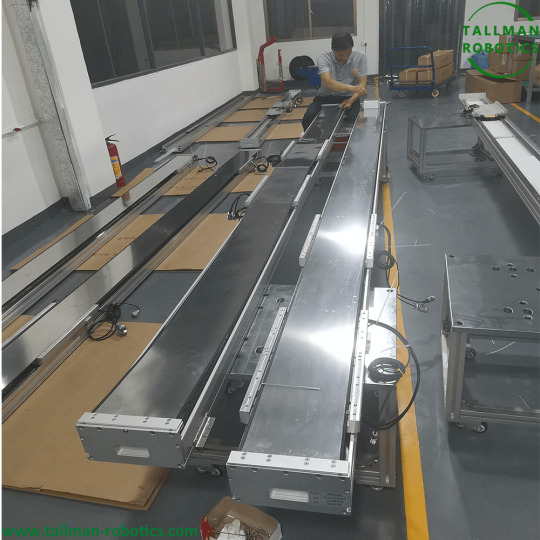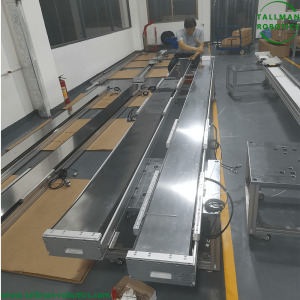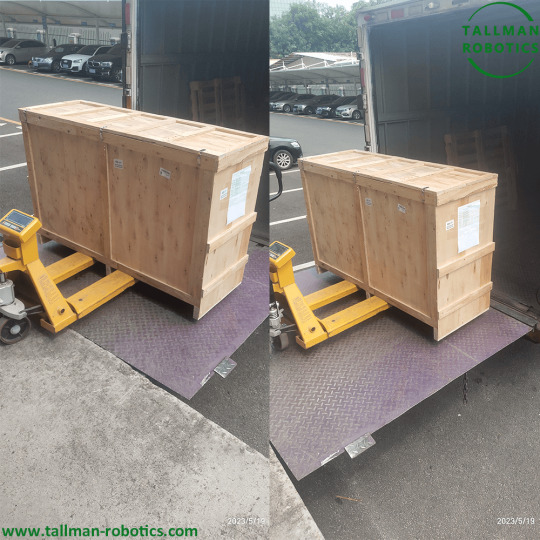#HighSpeedLinearModules
Explore tagged Tumblr posts
Text
High Speed Linear Motors Are Ready For Delivery To UK

High Speed Linear Motors from Tallman Robotics Will be Transported To UK.



Can you provide examples of control algorithms commonly used for High Speed Linear Motors? Certainly! Here are a few examples of control algorithms commonly used for linear motors: 1. Proportional-Integral-Derivative (PID) Control: PID control is a widely used control algorithm for High Speed Linear Motors. It calculates the control signal based on the error between the desired position and the actual position feedback. The PID controller consists of three components: the proportional term, the integral term, and the derivative term. The proportional term provides immediate response to the position error, the integral term eliminates steady-state errors, and the derivative term improves stability and responsiveness by anticipating future error trends. 2. Model Predictive Control (MPC): MPC is an advanced control algorithm that uses a mathematical model of the system to predict its future behavior. It optimizes a cost function based on the predicted trajectory and control inputs to generate the control signal. MPC takes into account system dynamics, constraints, and future setpoints to achieve precise motion control. It is particularly effective in applications where there are constraints on the motor and system behavior, such as minimizing overshoot or avoiding collisions. 3. Sliding Mode Control (SMC): SMC is a robust control algorithm that aims to make the system track the desired trajectory regardless of uncertainties and disturbances. It creates a sliding surface that the system attempts to reach and maintain. SMC uses a switching control law that actively adjusts the control signal based on the position error and its rate of change. This algorithm is known for its ability to handle nonlinearities and external disturbances, making it suitable for applications with varying loads or changing environmental conditions. 4. Adaptive Control: Adaptive control algorithms continuously adjust the control parameters based on thesystem's characteristics and changes in the operating conditions. These algorithms use online estimation or identification techniques to adapt to varying system parameters, such as load variations or changes in friction. Adaptive control algorithms aim to maintain accurate motion control by continuously updating the control signal based on the estimated or identified system parameters. 5. Feedforward Control: Feedforward control algorithms compensate for known disturbances or feedforward signals to achieve precise motion control. These algorithms calculate and apply a control signal based on the expected disturbance or desired trajectory before the feedback is received. Feedforward control algorithms can improve the system's response time and reduce tracking errors by preemptively compensating for known disturbances or inputs. It's important to note that the selection of the control algorithm depends on the specific requirements of the application, the system dynamics, and the desired performance criteria. Often, a combination of these control algorithms may be used to achieve the best results. The implementation details and parameter tuning of these algorithms may also vary depending on the specific control system and High Speed Linear Motors setup. You are welcome to https://www.youtube.com/@tallmanrobotics to watch our video centre for more projects or visit our website to check other series or load down e-catalogues for further technical data. Read the full article
#ElectricLinearActuators#Highspeedactuators#HighSpeedLinearModule#HighSpeedMotorizedLinearActuators#IronlessMotors#Linearmodules#LinearMotionActuators#LinearMotors#Sensorsforlinearmotors
0 notes
Text
Industrial Linear Motion Modules Are Picked Up to Germany

Industrial Linear Motion Modules Are Picked up to Germany.



Industrial Linear Motion Modules are mechanical systems designed to provide linear motion to various industrial applications. They consist of a combination of linear guides, actuators, and other components that enable precise and controlled movement of a load along a straight line. These modules are widely used in various industries such as manufacturing, automation, robotics, and material handling. Some common types of industrial linear motion modules include: - Linear Guides: These are mechanical components that provide support and guidance to the moving parts of a linear motion system. Linear guides typically consist of a rail and a carriage, with the rail providing a smooth surface for the carriage to slide along. - Linear Actuators: These are electromechanical devices that convert rotational motion from a motor into linear motion. Linear actuators can be divided into several types, such as screw-driven, belt-driven, and direct-drive actuators. - Ball Screws: A ball screw is a type of mechanical actuator that translates rotational motion into linear motion. It consists of a screw shaft and a ball nut, with ball bearings positioned between them to reduce friction and increase efficiency. - Linear Motors: These are direct-drive motors that generate linear motion without the need for any mechanical transmission components like gears or belts. They use magnetic fields to produce force, which moves the load along a linear path. - Linear Bearings: These are mechanical components that provide low-friction movement for linear motion systems. Linear bearings can be divided into several types, such as ball bearings, roller bearings, and plain bearings. - Linear Slides: These are pre-assembled systems that combine linear guides, actuators, and other components to provide a ready-to-use linear motion solution. Linear slides can be customized to meet specific application requirements. When selecting an industrial linear motion module, it is essential to consider factors such as load capacity, speed, accuracy, repeatability, and environmental conditions to ensure the chosen system meets the requirements of the specific application. You are welcome to https://www.youtube.com/@tallmanrobotics to watch our video centre for more projects or visit our website to check other series or load down e-catalogues for further technical data. Read the full article
#HighSpeedLinearModules#linearmodulesforprecisionmotionandindustrialautomationapplications#LinearMotionModules#LinearMotionProducts#LinearMotionSystems#MotorizedLinearStage
0 notes